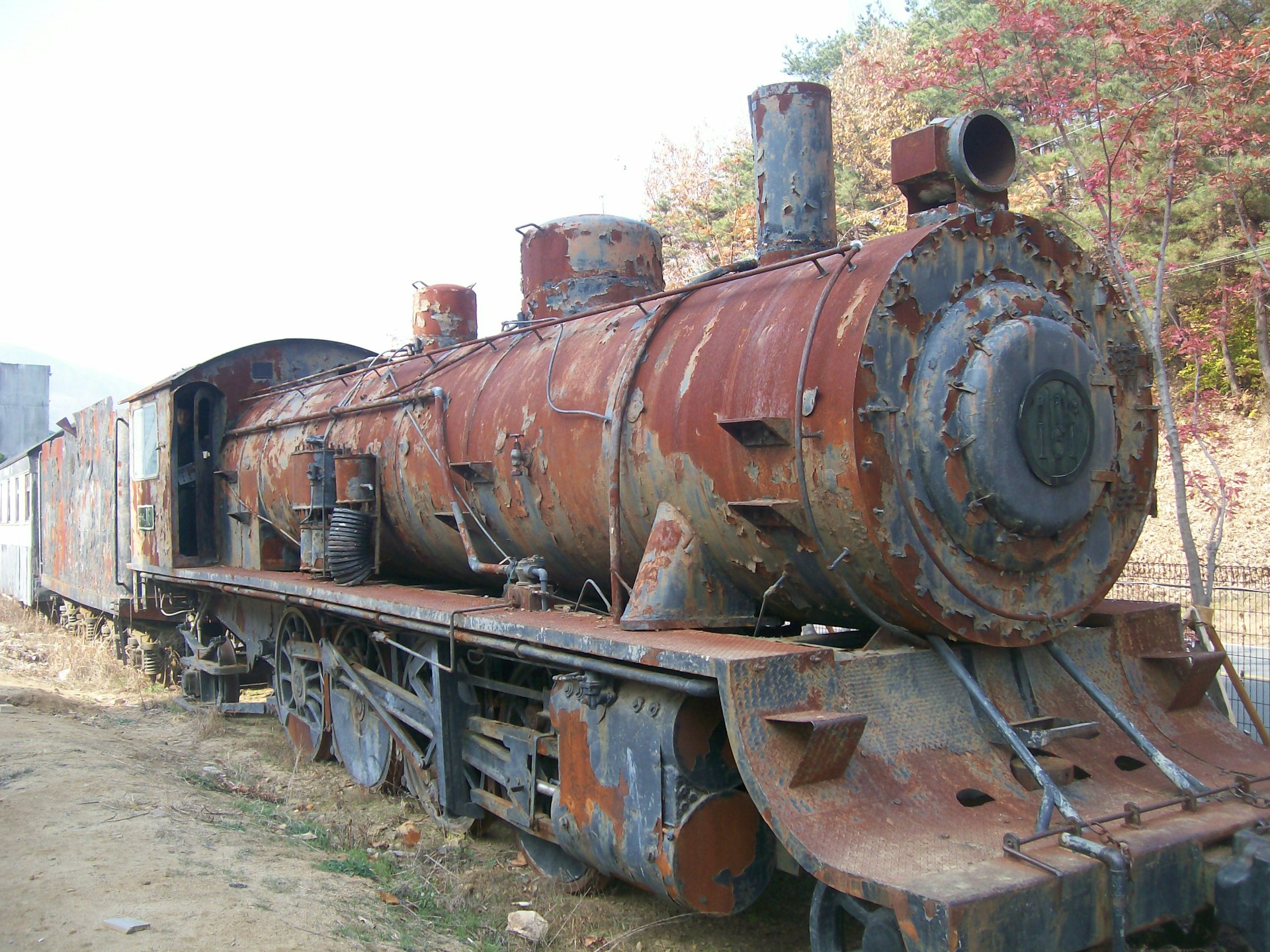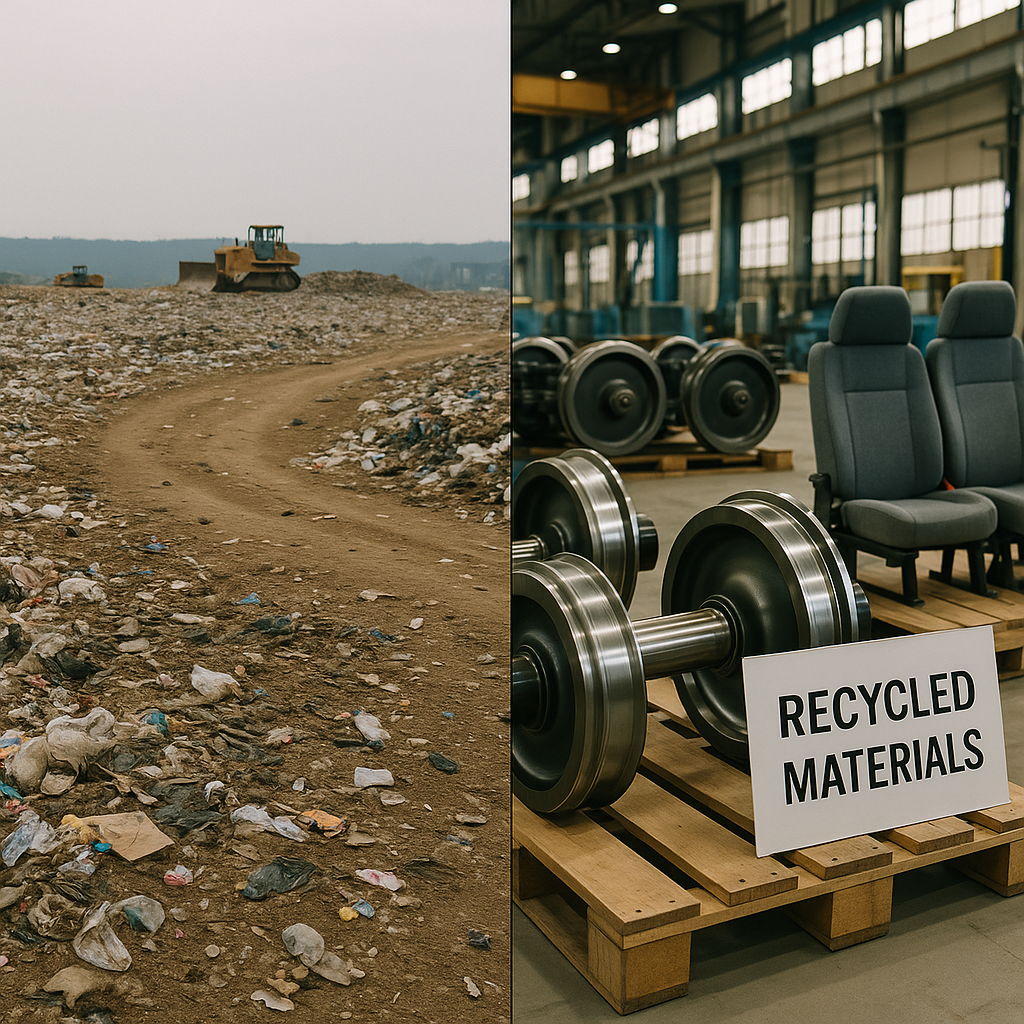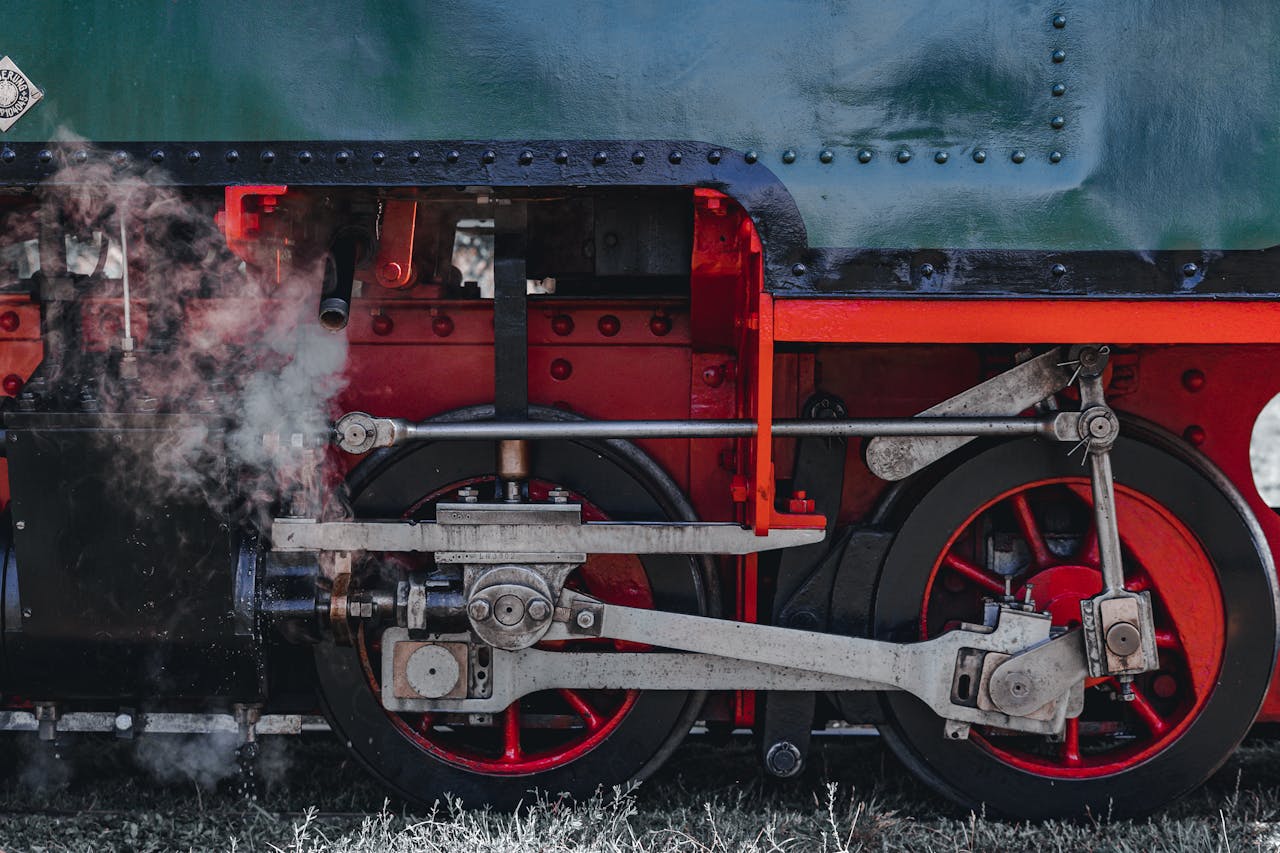5901 Botham Jean Blvd, Dallas, TX 75215
What Are Train Component Recycling Programs?
June 4, 2025For decades, decommissioned trains and railway components were simply buried in landfills, leading to environmental concerns and wasting valuable resources. Today, train component recycling programs are changing this practice. These initiatives focus on reducing the environmental impact in the railway industry through the systematic dismantling and repurposing of materials from end-of-life trains.
Train component recycling includes everything from metal parts to seat covers. The process involves carefully dismantling train cars and locomotives to extract reusable materials. A single mile of railroad track can produce approximately 90 tons of recyclable steel. This recovery process significantly reduces the need for new material extraction and manufacturing.
Railway companies worldwide are adopting these sustainability measures as part of their commitment to environmental stewardship. Instead of treating old trains as waste, these programs view them as valuable resources. The result is a more sustainable railway ecosystem that conserves natural resources while reducing the industry’s carbon footprint.
How Does the Train Component Recycling Process Work?

The train component recycling process follows a systematic approach that maximizes material recovery while ensuring environmental safety. It typically occurs in three stages: pre-treatment, dismantling, and milling. Each stage serves a specific purpose in the recycling chain.
Pre-Treatment Stage
The initial step in train recycling focuses on making the vehicle safe for further processing. During pre-treatment, all working fluids are carefully drained from the train into separate containers for specialized processing. This includes oils, brake fluids, and antifreeze materials.
Technicians also remove potentially hazardous materials during this stage. Fire extinguishers, batteries, capacitors, brake sand, and other harmful components are extracted and sent to specialized facilities for proper handling. This critical step prevents contamination and ensures workplace safety during subsequent recycling phases.
Dismantling Stage
The second phase involves the strategic removal of valuable components suitable for recycling or reuse. Workers extract major recyclable parts such as wheel sets, bogies, bogie frames, buffers, springs, couplings, and brake systems. These components undergo assessment to determine whether they can be reused directly or require refurbishment.
Additional elements removed during dismantling include glazing, electronics, seats, floors, and door systems. Most modern train cars are designed with dismantling in mind. Manufacturers now mark materials clearly and design connections that simplify the process. The components removed at this stage are sorted and sent to specialized recycling facilities appropriate for each material type.
Milling Stage
After extracting all recyclable parts, the remaining train structure moves to an industrial shredder for milling. This powerful equipment breaks down the vehicle into small fragments that can be easily sorted. The shredder effectively separates different materials based on their properties.
Metal sorting happens during this stage through various mechanical processes. Magnetic separation extracts ferrous metals like steel, while eddy current and density-based sorting systems recover non-ferrous metals such as aluminum and copper. The metal recovery rate is impressive, with approximately 68% of a train’s total mass typically consisting of recyclable metals recovered during milling.
The remaining shredder residue, which includes plastics, textiles, and other materials, undergoes further processing. Modern facilities can recover up to 67% of this shredder residue for recycling or energy recovery, though capabilities vary by location and available technology.
Through these three stages, the train component recycling process achieves remarkable efficiency. Modern train designs can reach recovery rates of up to 97%, significantly reducing waste while reclaiming valuable materials for future use.
What Materials Can Be Recycled from Trains?
Trains contain a diverse array of recyclable materials. Metals are the most abundant, comprising over 90% of a train’s total weight. Steel and aluminum make up most of a train’s structure, including the carbody, bogies, and framework. These metals maintain their properties during recycling and can be processed through magnetic separation techniques.
Ferrous metals like steel and cast iron have recovery rates between 90-98%, making them highly recyclable. Non-ferrous metals such as aluminum, copper, lead, and zinc can achieve recovery rates of 60-95% through dismantling, mechanical separation, and remelting processes.
Glass components, particularly windows and safety glass, can be recycled at rates of 50-100% through specialized remelting processes. Liquids from trains, including oils and lubricants, are collected during the pre-treatment phase and can be refined or used for energy recovery with recycling rates of 50-100%.
Modified organic natural materials found in trains include wood, leather, cotton, and cardboard. These materials have a recycling potential of 50-70% through various processing methods. Seats, interior panels, and flooring often contain these recoverable natural fibers.
Polymers and elastomers (excluding rubber) represent another significant recyclable category with recovery rates between 50-70%. These can be processed through dismantling, separation, dedicated recycling processes, or shredder light fraction recycling.
Electronic and electrical components from train systems can be recovered at rates of 60-85% through sorting and specialized recycling processes. These components require careful handling to extract valuable materials while properly managing hazardous substances.
Recycling Challenges
Despite high recycling potential for many materials, certain components still present significant challenges. Composite materials, particularly carbon fiber reinforced polymers (CFRP) and glass fiber reinforced polymers, lack economically efficient recycling technologies. These advanced materials are increasingly used in modern trains but pose recycling difficulties.
Plastic components also present recycling challenges due to their varied chemical compositions. Different types of plastics cannot be mixed during recycling as they have different melting temperatures and mechanical properties. This variety complicates the sorting and processing required for effective recycling.
Complex materials with multiple layers or combinations of different substances often end up as shredder residue. While approximately 50% of this residue contains combustible fractions suitable for energy recovery, the remainder typically requires landfill disposal.
The recycling process for trains follows three main stages: pre-treatment (draining fluids and removing hazardous components), dismantling (removing reusable parts and recyclable components), and shredding (processing the remaining materials). This systematic approach maximizes resource recovery while managing environmental impacts.
As train manufacturers increasingly incorporate recyclability into their designs, modern rolling stock can achieve impressive recovery rates of 95-98%. Companies like Alstom, Siemens, CRRC, and others now regularly promote the recyclability percentages of their new train models, highlighting the industry’s growing commitment to sustainability.
| Manufacturer | Train Model | Recyclability Rate |
|---|---|---|
| Alstom | Metropolis Metro Trains | 98% |
| Alstom | Avelia Horizon High-Speed Trains | 97% |
| Siemens Mobility | C2 Metro Trains | 97% |
| CRRC | Nanhu Low-Floor Tram | 90% |
| Stadler | Various Models | 97% |
| CAF | Various Models | 90.8-93.6% |
What are the Benefits of Train Component Recycling Programs?
Environmental Benefits
Train component recycling programs significantly reduce environmental impact through several mechanisms. Recycling steel from rail infrastructure requires much less energy than extracting and refining new materials. A single mile of railroad track can yield approximately 90 tons of recyclable steel.
These programs substantially decrease waste sent to landfills. According to industry research, poorly managed end-of-life trains can produce waste equivalent to about 20 cars. By implementing proper recycling protocols, nearly 97% of train materials can be successfully recycled or reused.
Carbon emissions reduction is another critical environmental benefit. The recycling process generates fewer greenhouse gas emissions compared to producing metals from raw ore. This aligns with global efforts to limit temperature increases to below 1.5°C, as agreed in the United Nations Framework Convention on Climate Change.
Economic Advantages
The economic benefits of train component recycling are compelling for both manufacturers and operators. Recycling reduces material purchase costs and production expenses, creating a favorable cost structure for companies investing in new infrastructure.
Steel and aluminum components, which make up over 90% of most trains by weight, are highly recyclable and economically viable to process. The recovery of these materials offsets decommissioning costs while supporting broader sustainability goals.
Railroad companies can generate revenue from recycled materials, helping to fund new infrastructure investments. This creates a financially sustainable cycle of resource management that benefits all stakeholders in the rail industry.
Supporting the Circular Economy
Train component recycling programs are central to resource reuse systems. They create a ripple effect of environmental advantages as materials flow through multiple lifecycles, transforming waste into valuable resources.
The European Union has extended ISO 22628 Recyclability standards to trains through ISO 21106. This framework promotes increasing the proportion of recyclable and reusable materials in train manufacturing. Leading manufacturers now achieve recycling rates of about 97% by following these standards.
These programs facilitate a virtuous cycle where materials are continuously recycled and reused at established rates. This systematic approach helps create a sustainable railway ecosystem through pre-emptive and comprehensive resource management strategies.
Innovation and Social Responsibility
Recycling programs drive innovation in sustainable design. Manufacturers increasingly manage materials from the design phase, considering recyclability as a core requirement alongside strength and durability. This leads to more environmentally conscious product development.
Railway companies fulfill important social responsibilities through these initiatives. As industries worldwide shift toward greener operations, the railway sector demonstrates environmental leadership by addressing waste management challenges throughout the entire product lifecycle.
Industry partnerships are developing advanced recycling technologies. These collaborations create more efficient methods to process materials and establish comprehensive circular economy frameworks. Their work includes specialized handling techniques for diverse materials with varying properties and recyclability requirements.
How are Train Manufacturers Embracing Recycling and Sustainability?

Train manufacturers worldwide have made impressive strides in integrating recyclability and sustainability principles into their core operations. Industry leaders have transformed their approach to design, production, and end-of-life management of rolling stock with remarkable results.
Alstom stands out as a sustainability pioneer with recyclability rates climbing from 87% to 97% over the past decade. Their Avelia Horizon high-speed trains for SNCF showcase this commitment. Even more impressive, Alstom’s newer models like the Metropolis metro trains for Paris and X’Trapolis EMUs for Spain boast 98% recyclability rates. These trains incorporate about 28% of materials made from recycled sources.
Siemens Mobility demonstrates similar dedication to sustainability. Their C2 metro trains developed for Munich feature 97% recyclability. This achievement reflects the company’s strategic focus on designing trains with end-of-life management in mind from the very beginning.
Chinese manufacturer CRRC has also made significant progress in sustainable manufacturing. Their trains achieve recycling rates up to 94%, with the Nanhu low-floor tram reaching 90% recyclability. CRRC reports considerable success in recovering and reusing materials, with over $152 million in raw materials sold to secondary markets.
Eco-Design Principles in Modern Train Manufacturing
Sustainable train design now goes beyond high recyclability percentages. Manufacturers implement comprehensive eco-design approaches that consider environmental impacts throughout a train’s entire lifecycle. This holistic perspective begins at the design phase and extends through manufacturing, operation, maintenance, and eventually, recycling.
The recycling process for trains involves several stages. It starts with pre-treatment, where working fluids, fire extinguishers, batteries, and other hazardous materials are safely removed. Next comes dismantling, where components suitable for reuse or recycling are extracted. Finally, the remaining structure undergoes milling, with metals sorted for further processing.
Components typically recovered include wheel sets, bogies, brake systems, and various metal parts. These can represent 75-95% of a train’s total weight, depending on the vehicle type. For example, passenger coaches yield about 75% recyclable materials, while freight cars reach up to 95%.
Train manufacturers now provide detailed end-of-life manuals to facilitate optimal recycling practices. These documents guide recycling facilities through the complex process of breaking down these massive vehicles while maximizing material recovery rates.
| Manufacturer | Recyclability Rate | Notable Models |
|---|---|---|
| Alstom | 97% | Avelia Horizon high-speed trains, Metropolis metro trains |
| Siemens Mobility | 97% | C2 metro trains for Munich |
| CRRC | Up to 94% | Nanhu low-floor tram |
| Stadler | 97% | |
| CAF | 90.8-93.6% | |
| Transmashholding (TMH) | 98% | |
| Sinara – Transport Machines | 98% |
International Frameworks Driving Industry Change
The shift toward sustainable manufacturing hasn’t happened in isolation. Various regulatory frameworks and industry initiatives have accelerated progress. The International Union of Railways (UIC) project called REUSE has been instrumental in creating tools that stimulate recycling within the rail sector.
The ISO 22628 standard, originally developed for the automotive industry, now provides guidance for calculating recyclability rates in railway equipment. Other important frameworks include the EU chemicals regulations REACH, the industry standard IRIS, and assessment methodologies like EcoVadis.
Organizations including Deutsche Bahn, SNCF, FS, SNCB, SBB, NetworkRail, and Trafikverket have collaborated on developing these sustainability frameworks. The European Commission now monitors the circularity level of EU economies using ten indicators, which includes environmental considerations in procurement processes.
These standards help create accountability and consistency across the industry. They ensure that when a manufacturer claims a high recyclability rate, this figure reflects genuine environmental benefit rather than marketing exaggeration.
Train manufacturers continue to innovate with sustainable materials and production methods. As technology advances and regulatory pressures increase, we can expect even higher recyclability rates and more comprehensive sustainability initiatives throughout the rail industry.
Conclusion: The Future of Train Component Recycling

Train component recycling is at the forefront of the railway industry’s sustainability efforts. Recent studies project recycling rates for mixed aluminum and steel to reach an impressive 96% by 2039. This advancement will significantly reduce landfill waste while supporting the circular economy in the transportation sector.
As railway companies increasingly adopt sustainable practices, the environmental and economic benefits will expand throughout the industry. For expert guidance on implementing effective recycling solutions for railway components and other industrial materials, contact Okon Recycling at 214-717-4083.
